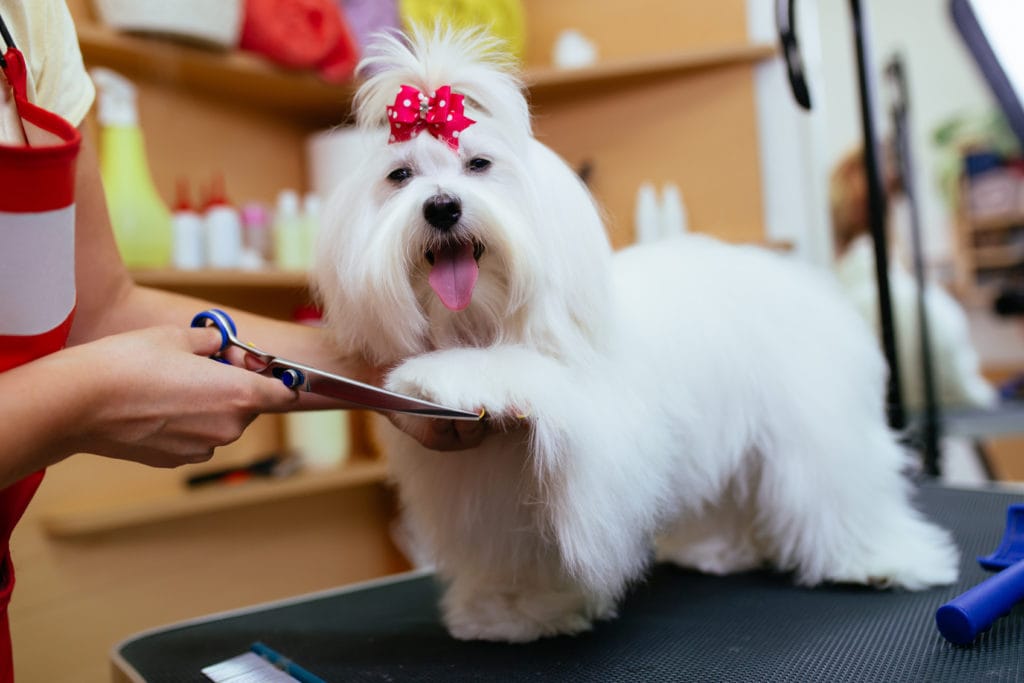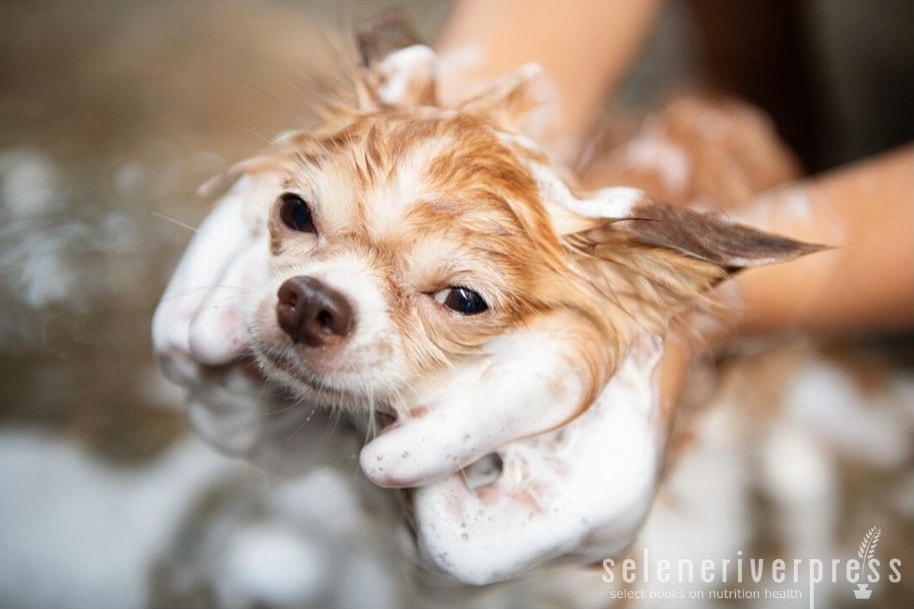When you think of good hygiene for your dog, what comes to mind? The ever so dreaded doggie bath! While an essential part of caring for our dogs includes regularly trimming their nails, cleaning their teeth and ears, and brushing their coats, most dogs don’t require hygiene and grooming every day (unlike their human counterparts).
Let’s talk about bath time. How often you give your dog a bath depends on their activity level, lifestyle, and coat type. Some dogs need a bath every other week while others are fine at every three months. Because dogs need the natural oils in their skin to promote hair growth, over-bathing can cause irritation and dryness. If you need guidance, ask your veterinarian how frequently (or infrequently) you should be bathing your pooch.
A successful, hassle-free bath is all about preparation. Before you start, make sure to have these essentials within reach:
- Dog brush
- Antiskid mat or towel for the bottom of the tub
- 2–3 towels
- Treats or peanut butter
- Dog shampoo (gentle, all-natural, created for dogs)
- Washcloth for the face
- Cotton balls if needed for the ears
- Toys for distraction
- Blow dryer (optional)
Traction. Many dogs struggle in the bath because their feet slip when they can’t gain traction. You might notice that they try to “grab” on to the bottom of the tub by extending their claws in a panic. An anti-skid mat or a towel on the bottom of your tub will make them feel much more comfortable and in control.
Brush your dog first. Before the bath, make sure to first brush your dog. A thorough brushing helps remove tangles that would only get worse when wet. This also helps remove loose hair that could clog your drain. And because matted hair holds water, it could leave your dog with irritated skin.
Use lukewarm water. No one likes a cold bath or shower, and smaller breeds tend to get chilled even easier. Keeping your dog warm will make a huge difference in how future baths will turn out as well. Check the temperature frequently to make sure it’s comfortable. To avoid getting water into your dog’s eyes or ears, use a cup to raise their nose to a 45-degree angle. (You can place cotton bolls in their ears if they’re prone to ear infections.)
Wash. Suds up a washcloth with dog shampoo. Never use human shampoo. The harsh chemicals and fragrances in human shampoos negate your dog’s natural ability to maintain a healthy, shiny coat. Clean around the eyes and in any folds on the face. Rinse well with water. Next, start at the neck and work your way to the tail, cleaning the genitals last.
Distract and reassure. Throughout the bath, make sure you talk to your pet in a calm and reassuring voice. Bring toys into the bath if your dog likes to play. Treats can also be a great distraction. One clever little trick is to smear peanut butter on the side of the tub. You can get a lot of scrubbing done as they enjoy their yummy treat.
Rinse. Make sure you rinse all of the shampoo out of the coat—you may have to rinse two or three times to get it all. Even a small amount of residual shampoo on the skin can develop into contact dermatitis—moist, pruritic (itchy), infected lesions called “hot spots.”
To condition or not condition? If your dog has dry skin or allergies, I don’t recommend using conditioners. But consider using Standard Process whole food supplements. These work from the inside out, addressing the systems that are failing, not the symptoms. Talk to your veterinarian about Standard Process Canine Dermal Support, Antronex, and Tuna Omega-3 Oil. These products are amazing, and I have seen great results.
Let your dog shake it off. Now that the bath is over, the biggest challenge is avoiding the water that will soon fly everywhere when your dog shakes his coat, leaving you wetter than him. Did you know that it only takes four seconds for a wet dog to shake off 70 percent of the water in his coat?! That’s a very messy bathroom. Therefore, after bath time I close the shower curtain (or door) and leave them in the tub alone. Give your dog a few minutes, and you’ll hear the shakes begin. Nature provided an effective way for furry animals to quickly dry off.
Finish drying. Once the shaking is complete, but before they’ve found their own way out of the tub, you can start the final drying process. I like to throw a towel over my dog’s back and use another one for the face, then the ears and feet. Then I take them out of the tub and continue to towel-dry the rest of the body. If your dog isn’t afraid of the noise, you can use a blow-dryer to speed things along. Be sure to use the cooler setting to avoid accidentally injuring your dog’s skin. Brushing the coat as you use the blow dryer can also help remove water deeper in the coat.
Many dogs will continue to try to shake after being out of the “shake zone.” Here’s a little trick to stop them: Once you see the shake begin, gently take hold of their muzzle with your thumb and forefinger, or hold the base of their neck. A dog starts to shake from the head back, and if he can’t rotate his head, he can’t rotate his body either.
Post bath time is my favorite. Dogs have nervous energy that gets bottled-up, and bath time is a common trigger. Once that stressful bath is over, you’ll see it being released. The minute they’re finally free from the bathroom, they often exhibit the “zoomies,” or FRAPS (frenetic random activity periods). Here are some of the most common reasons why dogs go crazy after a bath:
- Relief that bath time is over
- Getting their own scent back
- Trying to dry off and/or getting rid of water in their ears
- Releasing pent up energy
Whatever the reason, it’s always fun to watch. Just do not let your dog go outside during the zoomie phase until completely dry, or you may end up giving them another bath!
If bathing your dog at home seems like too much of an effort, consider a professional dog groomer (mobile groomers or a pet salon) and/or self-dog washes. Most self-dog washes provide you with all the supplies you need, including a raised tub that can save your back from bending over. Plus you don’t have to clean up the mess in your bathroom. Groomers will also clip your dog’s nails, express anal sacs (upon request), trim near the eyes, and dry them off.
Although most dogs would rather skip bath time, bathing plays an important role in the health of their coat and skin and keeps them free of dirt and parasites. And of course, there’s the added benefit of making your pooch more pleasant to be around.
Images from iStock/Kanoke_46 (main), Group4 Studio (post).


